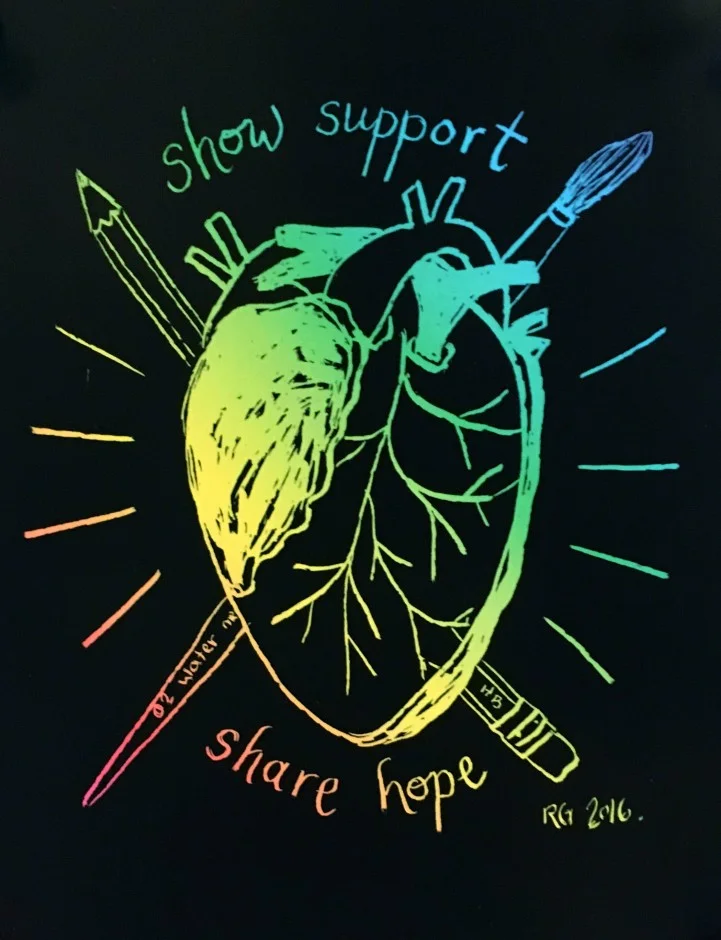Self harm is the act of intentionally injuring yourself in order to find relief from emotional or psychological distress. Self harm is a deliberate, controlled act and can take the form of cutting, burning, or preventing wounds from healing naturally. While self harm exists in the general population (1-4% of people engage in self harm), it is becoming increasingly common in adolescents. In recent years self harm has been addressed via social media. While some of this publicity has been to bring awareness to the behaviour in order to offer mental health support, there is also content available that glorifies self harm or even instructs adolescents on how to perform this behaviour. With incidence as high as 1 in 4 teens engaging in self harm, chances are that teens have a friend who engages in self harm, and they may be curious or feel pressure to experiment with this behaviour themselves. Today we’re sharing some information about self harm, exploring how art therapy can help, and offering ideas for how parents or friends can offer support to someone who is engaging in self harm.
Why do people self harm?
In 2009, 30 000 adolescents from six different countries were given a survey at school where they were asked about deliberate self harm. Those who engaged in self harm were asked to describe the reason for their most recent episode of self harm. Their responses were divided into two categories – a cry of pain (inward directed) or a cry for help (externally directed towards others). The most common reason given by both boys and girls was “I wanted to get relief from a terrible state of mind.” The researchers observed that “Although the study shows that there is also a cry for help, this type of motive seems to be less prominent than the cry of pain, which is inconsistent with the popular notion that adolescents’ deliberate self-harm is ‘only’ a cry for help.” (Scoliers et al., 2009, p.606). This research suggests that self harm is about coping with emotions as well as expressing a need for support.
Art therapist Diana Milia talks about self harm as “a self destructive act with positive intentions toward self-healing and symptom relief.” Self harm is not usually based on suicidal intent (people who self harm are not trying to die); instead it’s about non-verbally expressing and coping with strong emotions that feel overwhelming. The act of self harm is usually triggered by a thought or an overwhelming emotional state, and it does provide temporary relief from emotional distress. Self harm relieves tension, releases anger, helps individuals to regain a sense of control, relieves a state of feeling emotionally dead, brings calm feelings, and restores a sense of order. However, many people feel guilty or shameful after engaging in self harm, so this can become a negative cycle that reinforces the behaviour.
At Art as Therapy, we see connections between the process in art therapy and the act of self harm. The art making process allows clients to non-verbally express and cope with intense emotions that feel overwhelming. Through the therapeutic relationship and reflection on artwork, clients can learn how to talk about intense emotions and can build tools for more adaptive communication. Here are some ways in which the art therapy process can mirror the act of self harm:
- art is symbolic and there are preparations or rituals involved (similar to self-harm)
- the client maintains control when creating artwork and choosing what to say about it
- the client literally and purposefully “makes marks” during the art process
- art products are tangible proof that the client is real and was there (like scars)
- the experience of making art is physical and tactile, especially when using clay or paint
- in creation there is the inherent possibility of destruction (ripping, cutting, crushing, smashing art products)
Because of these similarities, art therapy can be a great fit for individuals who are engaging in self harm and would benefit from some emotional support. Art therapy may help clients to a) increase tolerance for emotional distress and to develop alternative coping strategies, and b) learn to appropriately identify, express, and talk about emotions. Through the art therapy process, clients may learn distraction, relaxation, and stress management techniques to use when feeling triggered or distressed.
Beyond receiving support from a mental health professional such as an art therapist, individuals who self harm need love and support from their friends and family. Discovering that your loved one is engaging in self harm can be an upsetting experience, and it can be challenging to know how to respond. When asked what helpful assistance they wished others would provide, individuals who engaged in self harm commented on the need to feel loved, validated and accepted. They wanted others to verbalize and demonstrate acceptance, and specified that they especially wanted this support from their parents.
Here are some ideas for how you can show support to someone who self harms:
- Try to stay calm. Do not instate negative consequences or give threats or ultimatums (do not take away cutting tools or check for new scars). Because self harm is a coping strategy, individuals need to learn new strategies before they can eliminate self harm.
- Acknowledge the severity of their distress. Validate their emotion, even if you disagree with their behaviour.
- Listen to them talk about feelings but withhold judgement. Here are some possible questions that you might ask, and helpful things to say:
- How do you feel before you self-injure?
- How do you feel after you self-injure?
- How does self-injury help you to feel better?
- What is it like for you to talk with me about hurting yourself?
- Is there anything that is really stressing you out right now that I can help you with?
- If you don’t wish to talk to me about this now, I understand. I just want you to know that I am here for you when you decide you are ready to talk.
- Let them know that you are available and able to help if needed (but make limits clear).
- Try suggesting some alternatives to self harm – (email us we can send you the document), it has lots of creative ideas for distraction techniques and alternative ways to cope with feelings.
- Verbalize and demonstrate love and acceptance.
Support people need support too! At Art as Therapy we are always looking for ways that we can offer support to individuals as well as families. If you have questions about self harm, or if you or someone you know could benefit from some support in coping with intense emotions, please call us at 1-519-307-9000 or email info@artastherapy.ca today. We look forward to connecting with you soon.Written by Rubi Garyfalakis, Art Therapist at Art as Therapy
References and Resources:
Kilburn, E. & Whitlock, J. Distraction Techniques and Alternative Coping Strategies. Cornell Program on Self-Injurious Behaviour in Adolescents and Young Adults.
Levenkron, S. (2006). Cutting: Understanding and Overcoming Self-Mutilation. New York: W. W. Norton & Co.
Milia, D. (1996). Art therapy with a self-mutilating adolescent girl. American Journal Of Art Therapy, 34(4), 98.
Myrick, A. “Incorporating Expressive Arts Techniques Into the Treatment of Adolescent Self-Injury.” Maryland.
Ryan, K., Heath, M., Fischer, L., & Young, E. L. (2008). Superficial Self-Harm: Perceptions of Young Women Who Hurt Themselves. Journal Of Mental Health Counseling, 30(3), 237-254.
Scoliers, G., Portzky, G., Madge, N., Hewitt, A., Hawton, K., de Wilde, E., & … Van Heeringen, K. (2009). Reasons for adolescent deliberate self-harm: a cry of pain and/or a cry for help?. Social Psychiatry & Psychiatric Epidemiology, 44(8), 601-607. doi:10.1007/s00127-008-0469-z.
Smith, M., & Segal, J. (2013). “Cutting and Self-Harm: Self-Injury Help, Support and Treatment.” http://www.helpguide.org/mental/self_injury.htm
Strong, M. (1998). A Bright Red Scream: Self-mutilation and the language of pain. New York: Penguin Books.
Sweet, M. & Whitlock, J. Information for Parents: What you need to know about self-injury. Cornell Program on Self-Injurious Behaviour in Adolescents and Young Adults.


